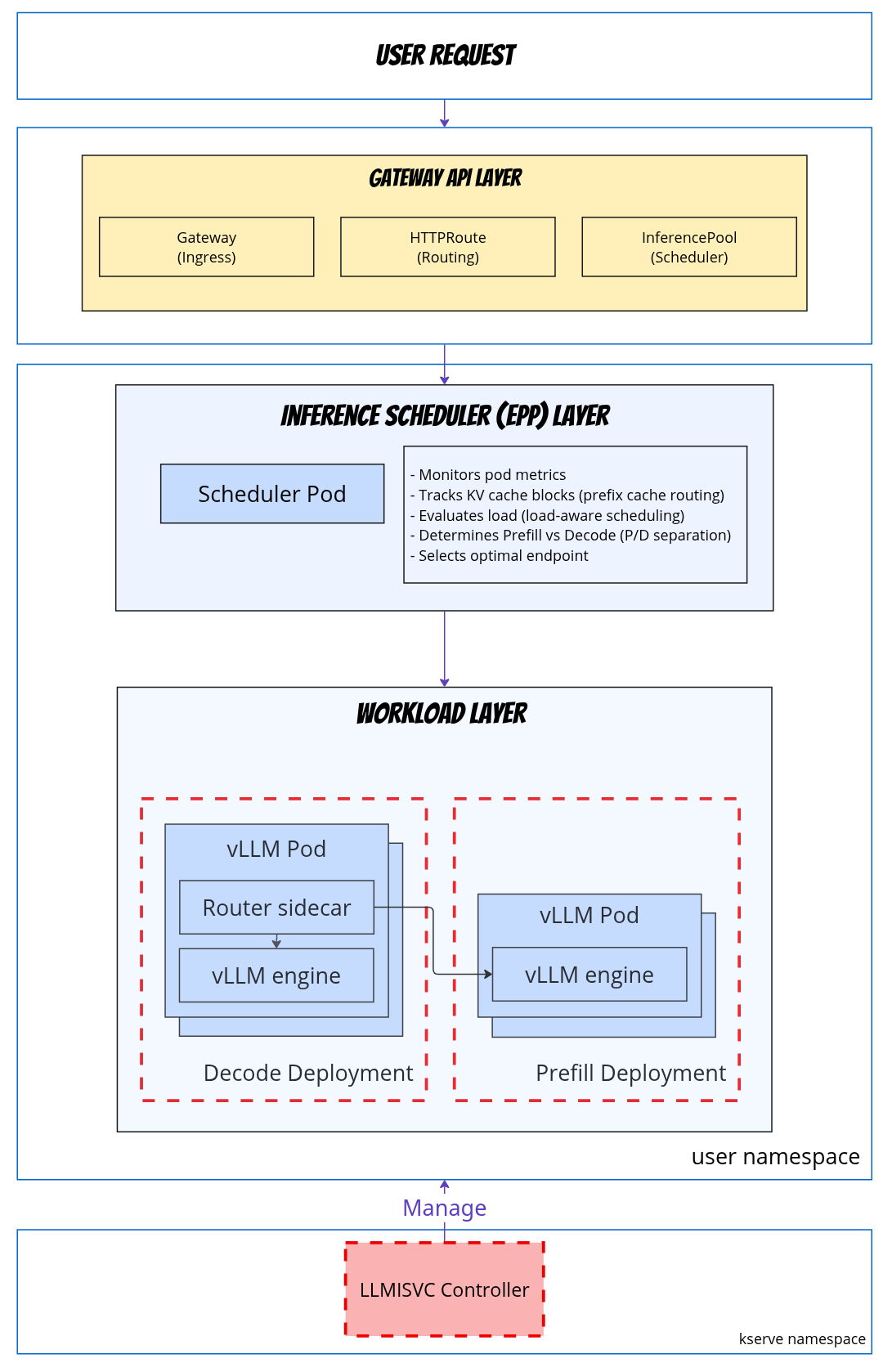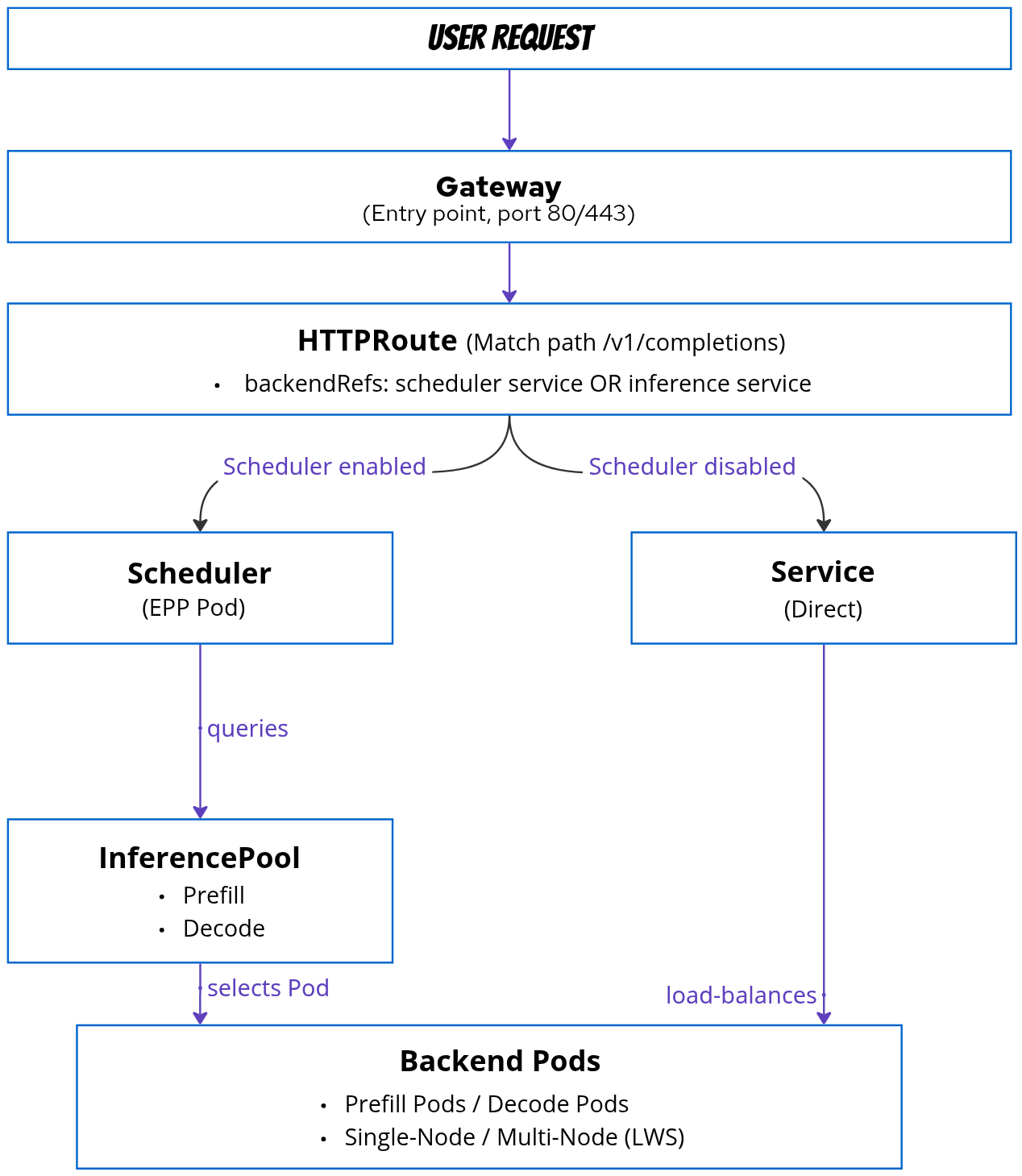LLMInferenceService Architecture Deep Dive
This guide provides an in-depth look at the LLMInferenceService architecture, component interactions, and advanced patterns for production deployments.
Prerequisites: Familiarity with core concepts and configuration is recommended.
System Architecture Overview

Gateway Architecture
What is a Gateway?
A Gateway is the entry point for external traffic into the Kubernetes cluster. It's a Kubernetes Gateway API resource that:
- Defines listeners (HTTP, HTTPS, ports)
- Configures TLS termination
- Managed by a Gateway Provider (Envoy Gateway, Istio, etc.)
- Can be cluster-scoped or namespace-scoped
Managed vs Referenced Gateway
Managed Gateway (Default)
spec:
router:
gateway: {} # KServe creates Gateway automatically
What KServe creates
apiVersion: gateway.networking.k8s.io/v1
kind: Gateway
metadata:
name: llama-3-8b-kserve-gateway
namespace: default
spec:
gatewayClassName: eg # Default: Envoy Gateway
listeners:
- name: http
port: 80
protocol: HTTP
Referenced Gateway (Existing)
spec:
router:
gateway:
refs:
- name: my-custom-gateway
namespace: istio-system
Use case: Shared gateway across multiple services.
HTTPRoute Architecture
What is an HTTPRoute?
An HTTPRoute defines path-based routing rules that connect Gateways to backend services (InferencePools or Services).
Managed HTTPRoute (Default)
spec:
router:
route: {} # KServe creates HTTPRoute automatically
What KServe creates
apiVersion: gateway.networking.k8s.io/v1
kind: HTTPRoute
metadata:
name: llama-3-8b-kserve-route
namespace: default
spec:
parentRefs:
- name: llama-3-8b-kserve-gateway
rules:
- backendRefs:
- group: inference.networking.x-k8s.io
kind: InferencePool
name: llama-3-8b-inference-pool
Routing Flow

Scheduler Architecture
Overview
The Scheduler (also called Endpoint Picker Pod - EPP) provides intelligent request routing based on:
- Prefix cache: Routes to pods with matching KV cache blocks
- Load: Balances requests across available endpoints
- Prefill-Decode separation: Routes to appropriate pool
Scoring Mechanism
The scheduler tracks KV cache blocks via ZMQ events from vLLM pods:
- BlockStored: Cache block created (includes block hash, tokens, storage location)
- BlockRemoved: Cache block evicted from memory
These events populate an index mapping {ModelName, BlockHash} → {PodID, DeviceTier}, allowing the scheduler to track which pods hold which cache blocks.
For each incoming request, the scheduler calculates a weighted score across all endpoints using pluggable scorers:
| Scorer | Weight | Purpose |
|---|---|---|
| Prefix cache scorer | 2.0 | Prioritizes pods with matching KV cache blocks |
| Load-aware scorer | 1.0 | Balances requests across endpoints |
| Queue scorer | (configurable) | Routes based on queue depth |
The request is routed to the highest-scoring pod, optimizing for both cache hit rate and load distribution.
Scheduler vs No Scheduler
| Feature | No Scheduler | With Scheduler |
|---|---|---|
| Routing | Kubernetes Service (kube-proxy) | InferencePool (EPP) |
| Load Balancing | Round-robin | Intelligent (load-aware, cache-aware) |
| Prefix Cache | ❌ | ✅ Routes to pods with matching KV cache |
| Prefill-Decode | ❌ | ✅ Automatic pool selection |
| Resource Overhead | Minimal (no extra pods) | Low (1 scheduler pod) |
| Use Case | Simple/Dev | Production |
Request Flow Analysis
Standard Request Flow
1. Client sends request
│
▼
2. Gateway receives (port 80/443)
│
▼
3. HTTPRoute matches path (/v1/completions)
│
▼
4. Routes to InferencePool
│
▼
5. Gateway queries EPP Service
"Which endpoint should I use?"
│
▼
6. EPP evaluates:
- Prefix cache match (weight: 2.0)
- Current load (weight: 1.0)
│
▼
7. EPP returns selected endpoint
"Use Pod 2 (10.0.1.42:8000)"
│
▼
8. Gateway forwards to Pod 2
│
▼
9. Pod 2 processes inference
│
▼
10. Response flows back to client
Prefill-Decode Request Flow
1. Client sends NEW request (no KV cache)
│
▼
2. Gateway -> HTTPRoute -> InferencePool
│
▼
3. EPP: "Calculate Score to decide which pod is the best to take this new request" → Route to Decode Pool
│
▼
4. Routing container (in selected Decode Pod) forwards request to Prefill Pod, which processes prompt and generates KV cache
│
▼
5. KV cache transferred to Decode Pod via RDMA if it needs
│
▼
6. Response includes KV transfer metadata
│
▼
7. Client sends CONTINUATION request (with KV cache ID)
│
▼
8. EPP: Calculate score (detects KV cache match on Decode Pod, skips Prefill) → Route directly to Decode Pod
│
▼
9. Decode Pod uses transferred KV cache
│
▼
10. Token-by-token generation
Network Flow
KV Cache Communication
LLM serving requires two types of KV cache communication:
1. KV Cache Event Tracking (ZMQ)
Purpose: Real-time monitoring of KV cache blocks for intelligent routing
- Protocol: ZMQ (Zero Message Queue) over TCP/IP
- Usage: vLLM publishes events when cache blocks are created/evicted
- Consumer: Scheduler (EPP) tracks which pods have which cache blocks (see Scoring Mechanism)
Configuration:
spec:
template:
containers:
- name: main
env:
- name: VLLM_ADDITIONAL_ARGS
value: "--kv-events-config '{\"enable_kv_cache_events\":true,\"publisher\":\"zmq\",\"endpoint\":\"tcp://scheduler:5557\",\"topic\":\"kv@${POD_IP}@model\"}'"
2. KV Cache Data Transfer (NixlConnector)
Purpose: Actual KV cache block transfer for prefill-decode separation
- Protocol: NixlConnector (RDMA-based, RoCE network)
- Usage: Transfer KV cache blocks from prefill pods to decode pods
- Use Case: Disaggregated prefill-decode architecture
Configuration:
spec:
template:
containers:
- name: main
env:
- name: KSERVE_INFER_ROCE
value: "true"
- name: VLLM_ADDITIONAL_ARGS
value: "--kv_transfer_config '{\"kv_connector\":\"NixlConnector\",\"kv_role\":\"kv_both\"}'"
Advanced Patterns
Pattern: Multi-Node Prefill-Decode
Combining P/D separation with LeaderWorkerSet:
spec:
# Decode workload (multi-node)
parallelism:
tensor: 4
data: 8
dataLocal: 4
template:
containers:
- name: main
resources:
limits:
nvidia.com/gpu: "4"
worker:
containers:
- name: main
resources:
limits:
nvidia.com/gpu: "4"
# Prefill workload (multi-node)
prefill:
parallelism:
tensor: 4
data: 16
dataLocal: 8
template:
containers:
- name: main
resources:
limits:
nvidia.com/gpu: "8"
worker:
containers:
- name: main
resources:
limits:
nvidia.com/gpu: "8"
Result:
- Prefill: 2 LWS replicas (16/8), each with 8 GPUs
- Decode: 2 LWS replicas (8/4), each with 4 GPUs
- Total: 24 GPUs
Next Steps
- Configuration Guide: Detailed spec reference
- Dependencies: Install required components